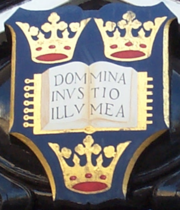Jesus College, Oxford
|
|
|||||||||||||||
| College name | Jesus College in the University of Oxford of Queen Elizabeth's Foundation | ||||||||||||||
| Named after | Jesus Christ | ||||||||||||||
| Established | 1571 | ||||||||||||||
| Sister college | Jesus College, Cambridge | ||||||||||||||
| Principal | The Lord Krebs | ||||||||||||||
| JCR president | Seán Mac labhraí | ||||||||||||||
| Undergraduates | 340 | ||||||||||||||
| MCR president | Liz Dollins | ||||||||||||||
| Graduates | 160 | ||||||||||||||
| Location | Turl Street, Oxford | ||||||||||||||
|
|
|||||||||||||||
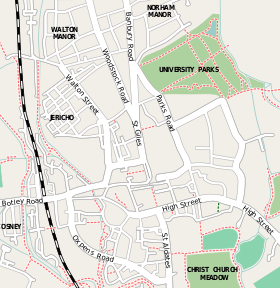 Location of Jesus College within central Oxford |
|||||||||||||||
| College Website | |||||||||||||||
| Boatclub Website | |||||||||||||||
Jesus College (in full: Jesus College in the University of Oxford of Queen Elizabeth's Foundation) is one of the constituent colleges of the University of Oxford in England. As of 2006 the college had a financial endowment of £119m.[1] The main entrance is on the west side of Turl Street. It is flanked by Ship Street to the north and Market Street to the south.
Jesus has been called "the first Protestant College in Oxford",[2] and was founded by Elizabeth I in 1571 for the education of clergy, though students now study a broad range of secular subjects. A major driving force behind the establishment of the college was Hugh Price (or Aprice), a churchman from Brecon in Wales, and the college continues to be associated informally with Wales to this day.[3] Today the college has around 500 students, and the Principal is Lord Krebs.[4]
Contents |
History

Jesus College was founded in 1571, occupying in part the site of the earlier White Hall, which had existed for several hundred years from the 13th century up until 1570, just before Jesus began. Jesus was founded by eight commissioners, of whom Hugh Price is usually credited as the main force, and received its Royal Charter from Elizabeth I.
The college was originally intended primarily for the education of clergymen. The particular intention was to satisfy a need for dedicated, learned clergy to promote the Elizabethan Religious Settlement in the parishes of England, Ireland and Wales. The college has since broadened the range of subjects offered, beginning with the inclusion of medicine and law, and now offers almost the full range of subjects taught at the university. The letters patent[5] issued by Elizabeth I made it clear that the education of a priest in the 16th century included more than just theology, however:
| “ | ...to the Glory of God Almighty and Omnipotent, and for the spread and maintenance of the Christian religion in its sincere form, for the eradication of errors and heresies, for the increase and perpetuation of true loyalty, for the extension of good literature of every sort, for the knowledge of languages, for the education of youth in loyalty, morality, and methodical learning, for the relief of poverty and distress, and lastly for the benefit and well-being of the Church of Christ in our realms, [...] we have decreed that a College of learning in the sciences, philosophy, humane pursuits, knowledge of the Hebrew, Greek and Latin languages, to the ultimate profession of Sacred Theology, to last for all time to come, be created, founded, built, and established.... | ” |
|
—Elizabeth I, Dated 27 June 1571. |
||
Hugh Price continued to be closely involved with the college after its foundation. On the strength of a promised legacy, worth £60 a year on his death, he requested and received the authority to appoint the new college's Principal, Fellows and Scholars. He financed early building work in the college's Front Quadrangle, but on his death in 1574 it transpired that the college received only a lump sum of around £600.

Significant benefactions in the 17th century placed the college on a more secure financial footing. One Herbert Westfaling, Bishop of Hereford, left enough property to support two fellowships and scholarships (with the significant proviso that "my kindred shallbe always preferred before anie others").[6] Sir Eubule Thelwall, principal from 1621–30, spent much of his own money on the construction of a chapel, hall and library for the college. This library, constructed above an overly-weak colonnade, was pulled down under the principalship of Francis Mansell (1630–49), who also built two staircases of residential accommodation to attract the sons of Welsh gentry families to the College.
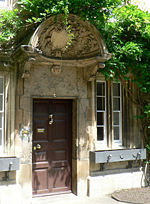
It was Leoline Jenkins, whose 1661–73 principalship followed Mansell's brief reinstatement, who secured the long-term viability of the college. On his death in 1685 he bequeathed a large complex of estates, acquired largely by lawyer friends from the over-mortgaged landowners of the Restoration period. These estates allowed the college's sixteen Fellowships and Scholarships to be filled for the first time (officially, sixteen of each had been supported since 1622, but the college's income was too small to keep all occupied simultaneously).[7]
In the inter-war years (1918–39) Jesus was seen by some as a small college and something of a backwater; it attracted relatively few pupils from the public schools traditionally seen as the most prestigious.[8] The college did, however, attract many academically able entrants from the grammar schools (particularly those in northern England and Scotland). Among these grammar-school boys was Harold Wilson, who would later become Prime Minister of the United Kingdom.[9]
In 1974, Jesus was among the first group of five men's colleges to admit women as members, the others being Brasenose, Wadham, Hertford and St Catherine's. Five women's societies (Lady Margaret Hall, Somerville, St Hugh's, St Hilda's and St Anne's) had been granted full collegiate status fifteen years earlier in 1959.
Jesus' long-standing rivalry with nearby Exeter College reached a peak in 1979, with seven police vehicles and three fire engines involved in dealing with trouble in Turl Street.[10]
Location and Buildings
Jesus is located on Turl Street in the centre of Oxford, on a comparatively small site by the standards of many Oxford colleges, and is one of the three Turl Street colleges along with Lincoln College and Exeter College. Much of what are considered the original buildings date from the 17th century, although parts date back to the college's foundation. Most of these earlier buildings have undergone some degree of restoration, although this is not generally obvious, and parts of the rear of the college are much more modern.

The main college buildings include the chapel (in the First Quadrangle) which was built in the early seventeenth century in Jacobean-Gothic style under Thelwall, and extended at the east end in 1636. It has a fine barrel vaulted roof, a late seventeenth-century ante-chapel screen and an early seventeenth-century pulpit. The chancel arch was widened in 1864 by George Edmund Street. The stone flooring and much of the woodwork also date from Street's alterations. The chancel features a Victorian stained-glass window and stone altarpiece, as well as a large copy of Guido Reni's St Michael subduing the Devil. This last item was given to the college by Thomas Bulkeley, 7th Viscount Bulkeley (a student in 1769), who acquired it in Rome during his Grand Tour. The organ, by the organ builder William Drake, was installed in 1994.


The college Hall, accessed from the screens passage that links the two main quadrangles, contains a fine full-length portrait of the college's Founder, Elizabeth I, attributed to Nicholas Hilliard or his school. This was presented to the college in 1687 by James Jeffreys, brother of George Jeffreys, the "Hanging Judge". Other portraits to be found here include contemporary likenesses of Charles I and Charles II, as well as numerous other benefactors, former Principals and alumni including T. E. Lawrence and Harold Wilson.
The college library provides an extensive lending collection, primarily for undergraduates, and supplements the (often reference-only) University libraries including the Bodleian. There is also an important Celtic collection. Notable antiquarian holdings include the Red Book of Hergest (one of two manuscript sources for the Mabinogion), a copy of the laws of Hywel Dda, and one of two manuscript copies of The Owl and the Nightingale. Some of these can be viewed online as part of the University's Early Manuscripts Imaging Project.[11]
In recent years the college has also built two annexes for student accommodation in the north and east of the city (named Stevens Close and Herbert Close respectively). Many students continue to live on the main central site, which remains the hub of the social and academic life of the college. The Herbert Close annexe, at which the college sports grounds are located, is also known as "Barts", after nearby Bartlemas.
Student life
The college has a reputation within Oxford for being a friendly, close-knit community.[12] Some have attributed this to the relatively small physical size of the main college site, where first-year students live in close proximity to one-another and form strong bonds of friendship and a keen sense of college spirit.
Students from the college participate in a variety of extracurricular activities, their successes not being limited to any one field in particular. Some contribute to student journalism for Cherwell or The Oxford Student. In the Arts, the annual Turl Street Arts Festival is of particular note. This week-long student-organised event is held annually in conjunction with Exeter and Lincoln colleges. The festival, which takes place in Fifth Week of Hilary term, includes exhibitions, plays and concerts. Although the college does not award Choral Scholarships, the Chapel Choir is well-attended by enthusiastic college members and others. The choir is non-auditioning for college members, and is run by one or more undergraduate Organ Scholars.
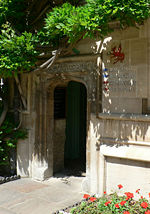
Sports
In common with many Oxford colleges, Jesus is well provided with sporting facilities. These include extensive playing fields at the east Oxford Bartlemas site for (association and Rugby union) football, field hockey, cricket, tennis etc., and modern squash courts at a separate city-centre site on St Cross Road. In addition, the college provides students with membership of the university's Iffley Road gym and swimming pool.[4]
The college boat house on the Isis is home to the Jesus College Boat Club. The club is one of the oldest rowing clubs in the world, and competed in Oxford's first Head Race (against Brasenose College Boat Club) in 1815.
Welsh connection
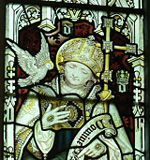
Although it accepts students from all over the United Kingdom and indeed the world, Jesus has a particular association with Wales and is often referred to as "the Welsh college". The college is home to the university's Professor of Celtic, and a specialist Celtic library in addition to the college's normal library. Meyrick scholarships, from the bequest of Edmund Meyrick in 1713, are awarded for academic merit where the student is a native of Wales (or the child of a native of Wales), able to speak Welsh or was educated for the last three years of secondary school in Wales.[13]
To reflect this connection, the college's undergraduate gossip sheet is entitled The Sheepshagger in allusion to an offensive joke about Welsh people's supposed penchant for sheep. Furthermore, the Welshness of the College is self-perpetuating, as Welsh students will often apply to Jesus because it is seen as the Welsh college. Old members recall the college having a majority of Welsh members until well into the 20th century;[14] today, however, around 15% of undergraduates come from Wales.[3] For comparison, the Welsh comprise around 5% of UK population.[15]
St. David's Day
In modern times, the Welsh roots of the college come to the fore most prominently on Saint David's Day. The feast is marked by a choral Evensong in the chapel, decorated for the occasion with the inevitable Daffodils. The service, including music, is conducted entirely in Welsh (despite only a small minority of the choir usually being native speakers of the language). It is generally well attended by members of the Welsh community in Oxford.[3]
The college's annual St. David's Day Dinner traditionally culminates with the serving of Sir Watkin Williams-Wynn's Pudding. The name recalls the Welsh politician and prominent Jacobite who attended the college early in the eighteenth century.
Silverware
Like many of the older Oxford colleges, Jesus has an impressive collection of silver. The most notable single item is a massive silver-gilt punch bowl, presented by Sir Watkin Williams-Wynn in 1732.[16] The bowl, which weighs more than 200 ounces (5.7 kg) and holds 10 imperial gallons (45 L), was most famously used at a dinner held in the Radcliffe Camera in 1814, to celebrate what was supposed to be the final defeat of Napoleon. Those present at the dinner included the Tsar, the King of Prussia, Blücher, Metternich, the Prince Regent, the Duke of York and the Duke of Wellington.[17] There is a college tradition that the bowl will be presented to anyone who can meet two challenges. The first is to put arms around the bowl at its widest point; the second is to drain the bowl of strong punch. The bowl measures 5 feet 2 inches (1.6 m) at its widest point, and so the first challenge has only been accomplished rarely; the second challenge has not been met.[18]
Coat of arms

The source of Jesus College's coat of arms is unknown. The arms were in use at the college by 1590, but unlike those of most Oxford colleges they are not known to have been adapted from those of a significant figure in the early years of the college's existence (for example, the founder).
In heraldic terminology: Vert, three stags trippant argent attired or.[19]
The arms, which originally had a blue field but later began to be used with the present green, depict three stags in profile with their right legs raised. The arms appear to be linked to those of the Green family.[20] The stag is the motif on the college crested tie.
College Prayers
The Founder's Prayer
This prayer, which gives thanks for Jesus College's foundation and benefactions, expresses the early hope that the college would produce graduates capable of providing leadership for both Church and State:
We praise and thank thee, O Lord, for thy servant, Elizabeth, Queen of England, our founder, and other our benefactors; humbly beseeching thee, that as they have charitably bestowed thy gifts to our relief, so both we may fruitfully use them to their due end, and other by such examples may be moved to provide for the maintaining of good learning; so that thy Church may be plentifully furnished with true preachers and dispensers of thy holy Word and Sacraments, and the Commonwealth well served in all necessities with godly and learned ministers; that we and our posterity may enjoy sincere religion with just government, and praise thy name forever.
The College Prayer
O God, by whose manifold grace all things work together for good for them that love thee; establish we pray thee, the good work thou hast begun in us, and make this College like a field that the Lord hath blessed; that whatsoever things are pure, true, lovely, and of good report, may here forever flourish and abound, through Jesus Christ our Lord.
Graces
The preprandial grace is read by a Scholar of the college at Formal Hall (the second, more elaborate sitting of dinner) on Wednesdays, Fridays and Sundays. It is relatively unusual for the grace after dinner to be read, as the custom is for those not dining on High Table to retire after finishing dinner, the Scholar who read the first grace having first requested permission from the Principal or the senior Fellow present.
Grace to be said before Dinner
Nos miseri et egentes homines pro cibo quem ad alimoniam corporis sanctificatum nobis es largítus, ut eo utamur grati tibi, Deus omnipotens, Pater caelestis, gratias reverenter agimus, simul obsecrantes ut cibum angelorum, verum panem caelestem, verbum Dei aeternum, Dominum nostrum Iesum Christum nobis impertiaris, ut illo mens nostra pascatur et per carnem et sanguinem eius foveamur, alamur et corróboremur.
We wretched and needy men reverently give thee thanks, almighty God, heavenly Father, for the food which thou hast sanctified and bestowed for the sustenance of the body, so that we may use it thankfully; at the same time we beseech thee that thou wouldst impart to us the food of angels, the true bread of heaven, the eternal word of God, Jesus Christ our Lord, so that our mind may feed on him and that through his flesh and blood we may be nourished, sustained and strengthened.
Grace after Dinner
Quandoquidem nos, Domine, donis tuis, omnipotens et misericors Deus, exsatiasti, effice ut posthac quid per nos fieri aut secus velis diligenter observemus, atque illud animo sincero effectum praestemus, per Iesum Christum Dominum nostrum.
VERSICLE — Domine, salvam fac Reginam.
RESPONSE — Et exaudi nos in die qua invocaverimus te.
Deus, in cuius manu sunt corda regum, qui es humilium consolator et fidelium fortitudo et protector omnium in Te sperantium, da Reginae nostrae Elizabethae populoque Christiano triumphum virtutis tuae scienter excolere, ut per te semper reparentur ad gloriam, per Christum Dominum nostrum.[21]
Since, O Lord, almighty and most merciful God, thou hast satisfied us with thy gifts, ensure from henceforth that we may diligently regard what thou wishest to be done or left undone by us and cause this to be effected with sincere heart, through Jesus Christ our Lord.
VERSICLE — O Lord, keep the Queen safe.
RESPONSE — And hear us in the day in which we call on thee.
God in whose hands are the hearts of Kings, who art the consoler of the humble and the protector of all who hope in thee, grant to our Queen Elizabeth and to the Christian people to celebrate wisely the triumph of thy goodness so that they may be always renewed to glory through thee, through Jesus Christ our Lord.[22]
People associated with the College
Principals and Fellows

The college is run by the Principal and Fellows. The Principal must be "a person distinguished for literary or scientific attainments, or for services in the work of education in the University or elsewhere".[23] The Principal has "pre-eminence and authority over all members of the College and all persons connected therewith" and exercises "a general superintendence in all matters relating to education and discipline".[24] The current Principal, Lord Krebs, was appointed in 2005 and is the thirtieth holder of the office. This figure does not include Seth Ward, who was elected Principal by the Fellows in 1657 but never installed since Oliver Cromwell, Chancellor of the University at the time, appointed Francis Howell instead.[25] Fourteen principals have been former students of the college, the first being Griffith Powell (elected in 1613) and the most recent being Alfred Hazel (elected in 1925). The longest-serving principal was Henry Foulkes, from 1817 to 1857.[26]
When the college was founded in 1571, the first charter installed David Lewis as Principal and named eight others as the first Fellows of the college.[27] The statutes of 1622 allowed for 16 Fellows.[28] There is now no limit on the number of Fellowships that the Governing Body can create.[29] The college statutes provide for various categories of Fellows.[30] Professorial Fellows are those Professors and Readers of the University who are allocated to the college by the University.[31] One of these professorships is the Jesus Professor of Celtic, which is the only chair in Celtic Studies at an English university. Celtic scholars such as John Rhys and Ellis Evans have held the position since its creation in 1877.[32] The current Professor of Celtic is Thomas Charles-Edwards.[33] The zoologists Charles Godfray and Paul Harvey are both Professorial Fellows.[34][35] Official Fellows are those who hold tutorial or administrative appointments in the college. Past Official Fellows include the composer and musiclogist John Caldwell, the historians Sir Goronwy Edwards and Niall Ferguson, the philosopher Galen Strawson and the political philosopher John Gray.[36][37][38][39][40] There are also Senior and Junior Research Fellows. Principals and Fellows who retire can be elected as Emeritus Fellows.[30] The college can also elect "distinguished persons" to Honorary Fellowships.[41]
A further category is that of Welsh Supernumerary Fellows, who are, in rotation, the Vice-Chancellors of Cardiff University, Swansea University, Lampeter University, Aberystwyth University, Bangor University and the University of Wales College of Medicine.[30] There is one Welsh Supernumerary Fellow at a time, holding the position for not longer than three years.[42] The first of these was John Viriamu Jones in 1897.[43]
The college formerly had a category of missionary Fellows, known as Leoline Fellows after their founder, Leoline Jenkins (a former principal). In his will in 1685, he stated that "It is but too obvious that the persons in Holy Orders employed in his Majesty's fleet at sea and foreign plantations are too few." To address this, he established two Fellowships at Jesus College, whose holders should serve as clergy "in any of his Majesty's fleets or in his Majesty's plantations" under the direction of the Lord High Admiral and the Bishop of London respectively. The last of these, Frederick de Winton, was appointed in 1876 and held his Fellowship until his death in 1932. This category was abolished in 1877 by the Oxford and Cambridge Universities Commission, without prejudice to the rights of existing holders such as de Winton.[44] Another category of Fellowship that was abolished in the 19th century was that of the King Charles I Fellows, founded by King Charles in 1636 and tenable by natives of the Channel Islands in an attempt by him to "reclaim the Channel Islands from the extreme Calvinism which characterised them."[45] The first such Fellow was Daniel Brevint.[45]
Whilst the founding charter did not require the Fellows or the students to be Welsh, many of the Fellows in the past were in fact Welsh. One reason for this was that when new Fellowships were created by benefactions (often by people of Welsh descent) there was frequently a stipulation that the recipients would be related to the donor or come from a place in Wales specified by the donor. These specific limitations were removed as part of reforms of Oxford University during the 19th century. In addition, between 1571 and 1915, only one Principal (Francis Howell, 1657–1660) was not from Wales or of Welsh descent.[46]
Alumni
Notable former students of the college have included politicians, scientists, writers, entertainers and academics. Perhaps the best-known former Jesus student is T. E. Lawrence ("Lawrence of Arabia"), who is widely known for his soldiery and leadership during the Arab Revolt of 1916–1918, and for his writings, including Seven Pillars of Wisdom. He is remembered in college as a fine historian, and his thesis on Crusader castles (the fieldwork for which marked the beginning of his fascination with the Middle East) remains in the college library today.[47]
Harold Wilson, Labour Prime Minister of the United Kingdom (1964–1970 and 1974–1976) was a Jesus man, as were Jamaican statesman Norman Washington Manley and Pixley ka Isaka Seme, founder and president of the African National Congress. Other former students include Sir William Williams (Speaker of the House of Commons 1680–85), D. J. Williams (a co-founder of Plaid Cymru) and Lord Sankey (Lord Chancellor 1929–1935). Members of Parliament from the three main political parties in the United Kingdom have attended the college, as have politicians from Australia (Neal Blewett), New Zealand (Harold Rushworth), Sri Lanka (Lalith Athulathmudali) and the United States (Heather Wilson).
The founders' hopes that their college would produce prominent Welsh clergy were fulfilled in no small measure when a former student, Alfred George Edwards, was elected the first Archbishop of Wales when the Church in Wales was disestablished in 1920.[48] Two later Archbishops of Wales, Glyn Simon (1968–1971) and Gwilym Owen Williams (1971–1982) were also educated at the college.[49][50]
Celticists associated with the college include Sir John Rhys, Sir John Morris-Jones, Sir Thomas (T. H.) Parry-Williams and Thomas Charles-Edwards, whilst the list of historians includes the college's first graduate, David Powel, who published the first printed history of Wales in 1584, and the Victorian historian J. R. Green. One former member, Angus Buchanan, won the Victoria Cross. Record-breaking quadriplegic solo sailor Hilary Lister was also a student here, whilst from the field of arts and entertainment there are names such as Magnus Magnusson, presenter of Mastermind, the National Poet of Wales Gwyn Thomas and television weather presenters Kirsty McCabe and Siân Lloyd.
References
General
- College publications
- "College Statutes" (pdf). Jesus College, Oxford. Retrieved on 2008-07-24.
- The Jesus College Record – annual publication. Cited in references as: JCR
- Histories of the College
- Hardy, E. G., Jesus College (1899) F. E. Robinson & Co., London. (Available online at www.archive.org.) Cited in references as: Hardy.
- Baker, J. N. L., Jesus College, Oxford 1571–1971 (1971) Oxonian Press Ltd, Oxford (ISBN 0950216402). Cited in references as: Baker, Jesus College.
- Other sources
- Sherwood, Jennifer; Pevsner, Nikolaus (1974). Oxfordshire. Buildings of England. Harmondsworth: Penguin Books. ISBN 0140710450.
Specific
- ↑ Oxford College Endowment Incomes, 1973-2006 (updated July 2007)
- ↑ Laurence Hutton, quoting J.R. Green (1903). "Literary Landmarks of Oxford: Jesus". Charles Scribner's Sons. Retrieved on 2006-08-24.
- ↑ 3.0 3.1 3.2 Jesus College, Oxford (2007-02-13). "Jesus College and Wales". Retrieved on 2007-03-15.
- ↑ 4.0 4.1 University of Oxford (2007-03-09). "Jesus : 2008/9 Oxford University Undergraduate Admissions". Retrieved on 2007-03-22.
- ↑ Baker, J.N.L. (1971). Jesus College Oxford 1571-1971. Oxford: Oxonian Press. ISBN 0950216402.
- ↑ Speight, Martin (2004). "Westfaling, Herbert (1531/2–1602)". Oxford Dictionary of National Biography. Oxford University Press. Retrieved on 2006-06-29.
- ↑ Jesus College, Oxford (2002-05-14). "Benefactors". Retrieved on 2006-06-29.
- ↑ Pimlott, Ben (1992). Harold Wilson. London: Harper Collins. ISBN 0002151898.
- ↑ Jesus College, Oxford (2002-07-18). "The 20th Century". Retrieved on 2006-04-04.
- ↑ Unknown (Trinity term 1999). "Oxford at War?". The Oxford Student (Oxford Student Services Limited). http://www.oxfordstudent.com/tt1999wk0/Features/oxford_at_war_%3F. Retrieved on 2007-03-22.
- ↑ "Jesus College". Early Manuscripts at Oxford University. Retrieved on 2007-04-12.
- ↑ OUSU (2005). "Jesus". The Oxford Handbook. Oxford Student Services Limited. Retrieved on 2007-03-15.
- ↑ "Scholarships and Exhibitions (Undergraduates)". Jesus College, Oxford (20 September 2005). Retrieved on 2008-04-25.
- ↑ Garnier, Edward (2003-01-23). "Debate on Hunting Bill, House of Commons Standing Committee F". Retrieved on 2007-03-15.
- ↑ List of United Kingdom nations by population
- ↑ Glanville, Philippa (2004). "A Treasured Inheritance". Oxford Today (Oxford University Public Affairs Directorate) 16 (3). http://www.oxfordtoday.ox.ac.uk/2003-04/v16n3/07.shtml. Retrieved on 2007-03-15.
- ↑ Popkin, Michael (November 2001). "War and Peace". Oxford Inscriptions: Inscribed Stones and Plaques in Oxford. Retrieved on 2007-03-15.
- ↑ Thomas, Llewellyn (1891). "Jesus College". in Clark, Andrew. The colleges of Oxford: their history and traditions. London: Methuen & Co. pp. 387. http://www.archive.org/details/collegesofoxford00clarrich. Retrieved on 2008-08-19.
- ↑ Oxford University Calendar 2004-2005 (2004) p.255. Oxford University Press ISBN 0-19-951904-8.
- ↑ Walker, David (2004). "Price, Hugh". Oxford Dictionary of National Biography. Oxford University Press. Retrieved on 2007-03-22.
- ↑ Jesus College, Oxford (2002-06-24). "Graces". Retrieved on 2007-03-28.
- ↑ Adams, Reginald, The College Graces of Oxford and Cambridge The Perpetua Press, Oxford (1992) pp. 68 and 95. From a card for use by the scholar on duty, translations by J. G. Griffith, Fellow of the college and Public Orator from 1973 to 1980. ISBN 1-870882-06-7.
- ↑ Statute III "The Principal", clause 1 "Qualifications"
- ↑ Statute III, clause 4(a) "Duties"
- ↑ Henry, John. "Ward, Seth (1617–1689)". Oxford Dictionary of National Biography. Oxford University Press. Retrieved on 2008-04-10.
- ↑ Baker, J. N. L (1954). "Jesus College". A History of the County of Oxford: Volume 3: The University of Oxford 264–279. University of London Institute of Historical Research. Retrieved on 2008-07-28.
- ↑ "Jesus College, Oxford – The Founders". Jesus College, Oxford (14 November 2000). Retrieved on 2008-02-24.
- ↑ "Benefactors". Jesus College, Oxford (14 May 2002). Retrieved on 2008-07-24.
- ↑ Statute IV "The Fellows", clause 3 "Number of Fellowships"
- ↑ 30.0 30.1 30.2 Statute IV, clause 1 "Classes of Fellows and qualifications"
- ↑ Statute IV, clause 5 "Professorial Fellowships"
- ↑ "Celtic at Oxford". Retrieved on 2007-07-15.
- ↑ "Professor Thomas Charles-Edwards". Jesus College, Oxford (18 January 2006). Retrieved on 2008-07-24.
- ↑ "Charles Godfray". Department of Zoology, University of Oxford (2008-03-06). Retrieved on 2008-04-03.
- ↑ "Professor Paul Harvey". Jesus College, Oxford (2008-05-23). Retrieved on 2008-07-07.
- ↑ De'Ath, John (1999). "Fellows' News". JCR: 15.
- ↑ "Sir Goronwy Edwards – A loyal and learned Welshman", The Times (21 June 1976), p. 16.
- ↑ Clarke, Peter (2002). "Fellows' News". JCR: 18.
- ↑ De'Ath, John (2000). "Fellows' News". JCR: 19.
- ↑ De'Ath, John (1997/8). "Fellows' News". JCR: 15.
- ↑ Statute IV, clause 23 "Honorary Fellowships"
- ↑ Statute IV, clause 4 "Welsh Supernumerary"
- ↑ Baker, Jesus College, pp. 62–63
- ↑ Hazel, Alfred (3 May 1932). "The Rev. F. H. de Winton", The Times, p. 19.
- ↑ 45.0 45.1 Hardy, p. 77
- ↑ "The Welsh College". Jesus College, Oxford (12 November 2000). Retrieved on 2008-07-24.
- ↑ Jesus College, Oxford (2005-12-27). "History". Jesus College Prospectus. Retrieved on 2007-03-29.
- ↑ Duncan-Jones, A. S; Jones, O. W. "Edwards, Alfred George (1848–1937)". Oxford Dictionary of National Biography. Oxford University Press. Retrieved on 2007-07-14.
- ↑ Walker, David. "Owen, John (1854–1926)". Oxford Dictionary of National Biography. Oxford University Press. Retrieved on 2007-07-14.
- ↑ "Old Members: News and Notes". Jesus College Record (Jesus College, Oxford): 53–54. 1992.
External links
|
|||||||||||||
|
|||||||||

